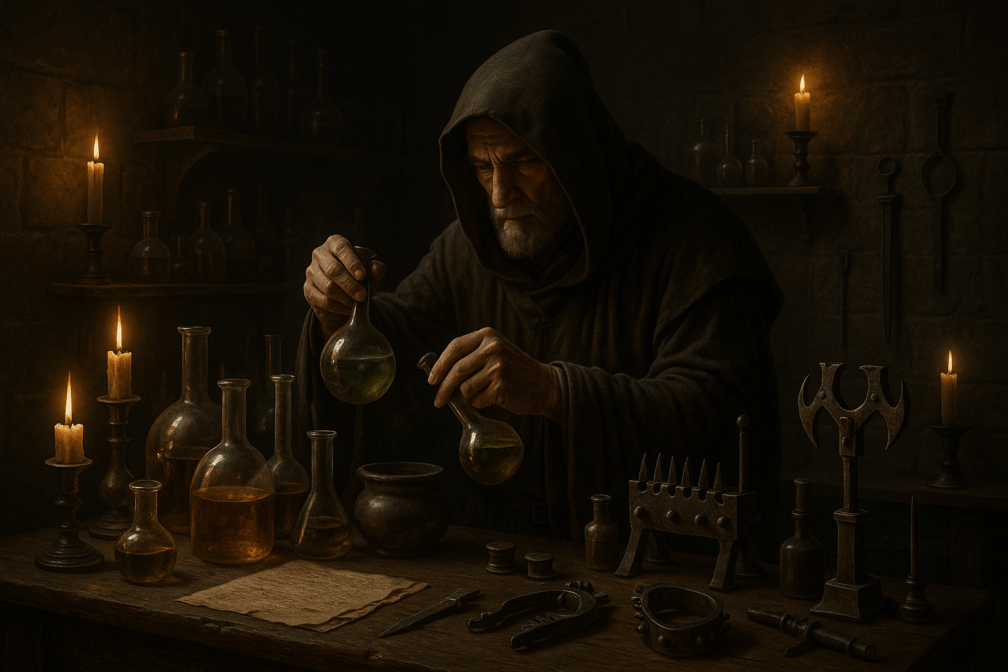Throughout medieval times, the boundary between science and cruelty was frequently blurred, especially in the shadowy world of alchemy. Alchemists, known primarily for their attempts to transmute base metals into gold and their pursuit of eternal life, also played a sinister role in devising brutal methods of torture. This grim intersection is vividly explored through medieval alchemy punishments, reflecting a darker side of human curiosity and ingenuity.
Alchemists’ Role in Torture: Fact or Fiction?
The alchemists’ role in torture is not merely myth or fantasy; historical records reveal their direct involvement in developing torture devices and methods. Alchemists, with their deep knowledge of chemicals and natural elements, contributed significantly to the creation of instruments that amplified pain. These devices became notorious not only for their brutality but also for the scientific precision behind their design.
Scientific Cruelty of Medieval Times
During the Middle Ages, the pursuit of knowledge often went hand-in-hand with extreme measures. This period witnessed countless cruelty in medieval alchemy experiments, where human suffering became collateral damage in the quest for scientific understanding. Victims frequently found themselves at the mercy of experiments that explored the limits of human endurance, pain tolerance, and resilience.
Medieval Alchemists’ Torture Methods
Alchemists brought innovation to torture methods, infusing their extensive knowledge of metals, acids, and poisons into punishment devices. Among the most notorious torture inventions by medieval alchemists were devices that employed chemicals to cause prolonged agony. Instruments such as the “chemical cauldron,” in which prisoners were exposed to harmful fumes, underscored the terrifying creativity and expertise these scientists wielded.
Alchemy and Medieval Executions
The relationship between alchemy and medieval executions was significant, with alchemists often serving as advisers to executioners. Their expertise allowed for executions that were meticulously planned and executed with a chilling scientific precision, turning public punishments into macabre displays of power and knowledge. Such executions reinforced societal control through fear, demonstrating the ruthless application of scientific understanding to inflict maximum punishment.
Role of Alchemists in Medieval Justice
Alchemists didn’t merely act as passive contributors; their role extended deeply into the legal systems of the era. The role of alchemists in medieval justice was often formalized, as they provided crucial evidence in trials, frequently manipulating substances to determine guilt or innocence through scientifically dubious yet widely accepted methods. Their participation added a veneer of legitimacy to what often amounted to judicial brutality.
Medieval Science and Punishment
The fusion of medieval science and punishment highlights the dangerous potential when knowledge is wielded without ethical restraint. Alchemists’ involvement underscores the thin line between scientific curiosity and outright cruelty, showcasing how the pursuit of knowledge could easily be twisted into instruments of oppression and violence.
Visiting the Scenes of Historical Cruelty
For those intrigued by this dark chapter of history, visiting torture museums can provide vivid insights into these historical realities. The Medieval Torture Museum in Chicago is a prime destination for exploring detailed reconstructions of these macabre inventions, offering a unique perspective on historical torture practices.
Similarly, the Medieval Torture Museum in LA and the Medieval Torture Museum in St. Augustine feature extensive collections that delve deeply into the brutal and innovative methods designed by alchemists. These museums represent vital institutions preserving the history of medieval punishment devices created by alchemists.
Learning and Reflecting
By understanding this unsettling aspect of history, visitors and readers alike can better appreciate the evolution of ethics in scientific research. Such explorations prompt reflection on how societies must vigilantly guard against cruelty in scientific pursuits. For more fascinating insights and historical contexts, the museum’s regularly updated blog offers articles and narratives that deepen our understanding of these complex issues.
Learning and Reflecting
By understanding this unsettling aspect of history, visitors and readers alike can better appreciate the evolution of ethics in scientific research. Such explorations prompt reflection on how societies must vigilantly guard against cruelty in scientific pursuits. For more fascinating insights and historical contexts, the museum’s regularly updated blog offers articles and narratives that deepen our understanding of these complex issues.






